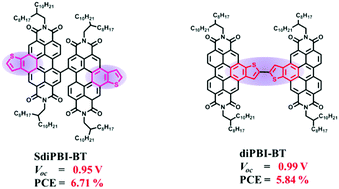Thienobenzene-fused perylene bisimide as a non-fullerene acceptor for organic solar cells with a high open-circuit voltage and power conversion efficiency†
Abstract
Perylene bisimide (PBI) based molecules have recently attracted tremendous interest as acceptors in non-fullerene organic solar cells. However, most PBI-based acceptors possess deep LUMO energy levels (−3.9 ∼ −4.0 eV) and show an open-circuit voltage (Voc) below 0.90 V, thus limiting the improvement of device efficiency. Here, we report two novel ring-fused PBI dimers, SdiPBI-BT and diPBI-BT, with thienobenzene fused to the bay region of the PBI subunits. Conventional bulk-heterojunction (BHJ) solar cells based on SdiPBI-BT show a power conversion efficiency (PCE) of 6.71% with a high Voc value of 0.95 V, a short-circuit current density (Jsc) of 10.31 mA cm−2 and a high fill factor (FF) of 68.7%. Devices based on diPBI-BT show a PCE of 5.84% with a high Voc value of 0.99 V. These results demonstrate that ring-fused PBI derivatives are promising materials for non-fullerene cells.

- This article is part of the themed collection: Materials Chemistry Frontiers HOT articles for 2017

 Please wait while we load your content...
Please wait while we load your content...